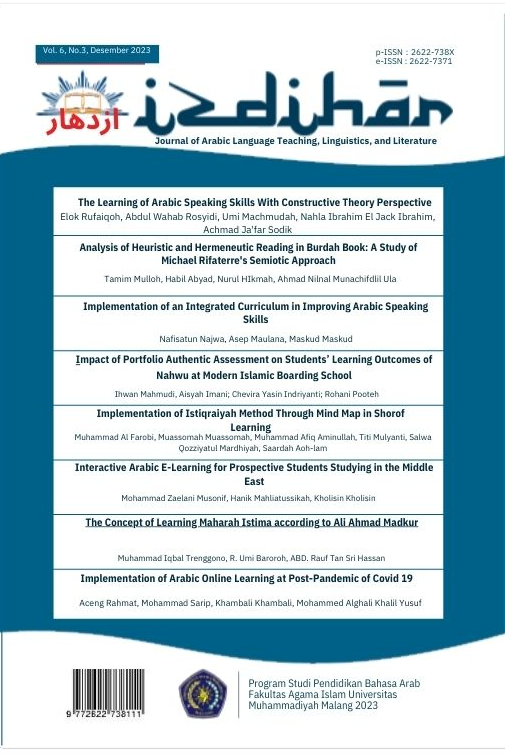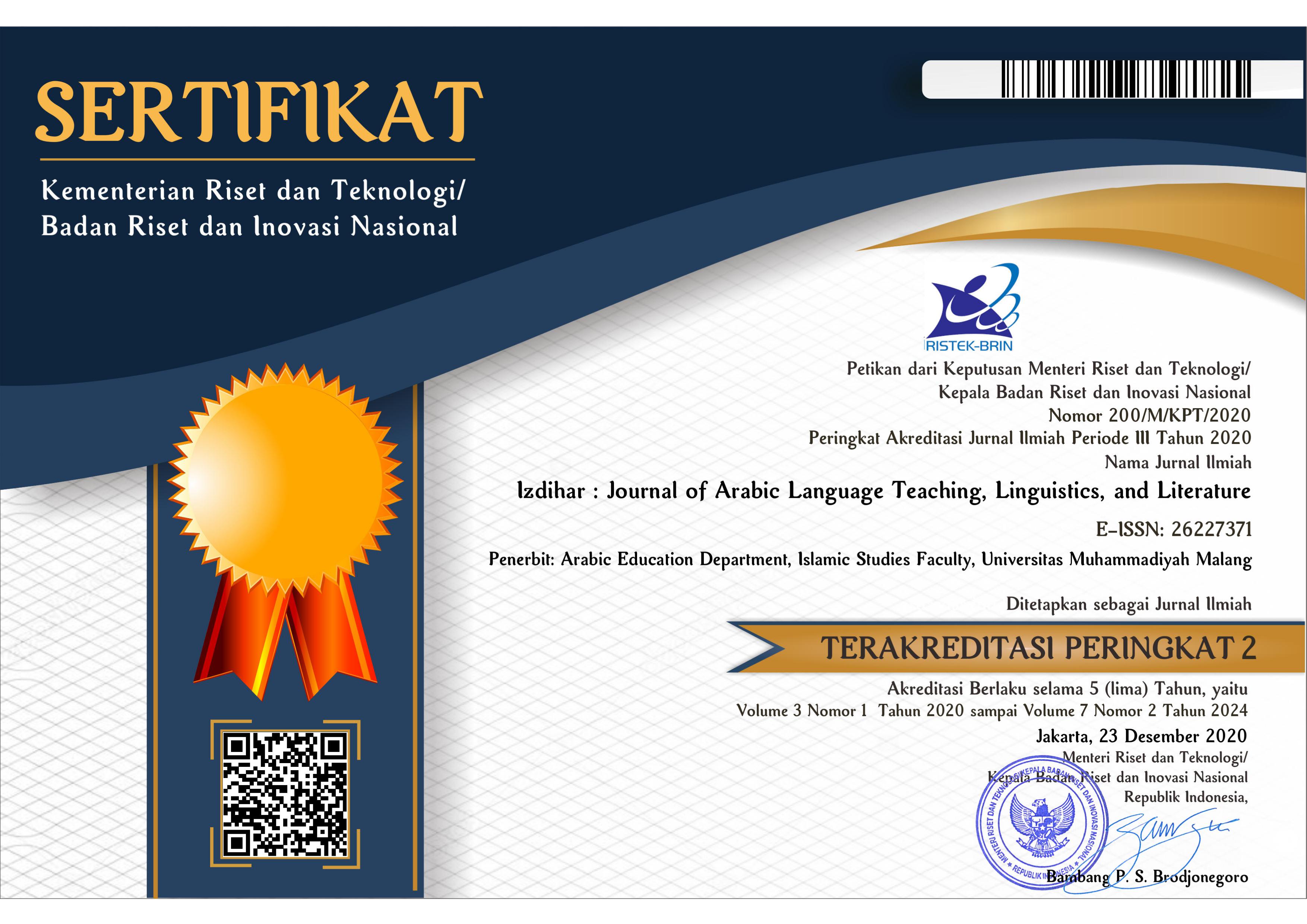Implementation of Istiqraiyah Method Through Mind Map in Shorof Learning
DOI:
https://doi.org/10.22219/jiz.v6i3.25866Keywords:
Istiqraiyah Method; Mind Map; Shorof LearningAbstract
This study aimed to describe the steps of applying istiqraiyah method through mind maps in Shorof learning and to find out students' interest in applying istiqraiyah method through mind maps in Shorof learning in Maulana Malik Ibrahim Islamic State University of Malang. This study used mix methods; descriptive qualitative, it describes the steps of applying istiqraiyah method through mind maps in Shorof learning and quantitative, it is to answer students' influence and interest in applying istiqraiyah method through mind maps in Shorof learning. Data collection techniques used interviews, observation, and questionnaires. Quantitative data analysis used the Likert theory to calculate the value of student interest taken from the questionnaire. The results of the study showed that the first step in applying istiqraiyah method through mind maps in Shorof learning is to provide several examples of sentences from al-fi’lul lazim and al-fi’lul muta’adias insights and descriptions, then compiled in a mind map in the form of a definition format, definitions, signs, meanings, wazan, patterns, and ways of changing the usual al-fi’lul lazim to al-fi’lul muta’adi which also begins with various examples. Istiqraiyah method through mind maps in Shorof learning increases the average pre-test and post-test scores of 30.83, which results in a value of 0.73 based on the Gain test, so it is in the high category. As for students' interest in applying istiqraiyah method through mind maps in Shorof learning, it has a presentation index of 73.2% and included in the strong category.
Downloads
References
A.G.Ganiev, A.M.Mukhammadiyev, & M.T.Nurbayeva. (2021). Exploration Of Alisher Navai’s “Khamsa” With A Mind Map. Turkish Journal of Computer and Mathematics Education (TURCOMAT), 12(4), 37–42. https://doi.org/10.17762/turcomat.v12i4.467
Buran, A., & Filyukov, A. (2015). Mind Mapping Technique in Language Learning. Procedia - Social and Behavioral Sciences, 206(November), 215–218. https://doi.org/10.1016/j.sbspro.2015.10.010
Drupadi, S. W., & Mumu, J. (2018). Analisis Kemampuan Penalaran Induktif Matematis Mahasiswa Pendidikan Matematika Universitas Papua. Journal of Honai Math, 1(2), 113. https://doi.org/10.30862/jhm.v1i2.1048
Endah, & Nashirudin. (2019). Eksperimentasi Metode Mind Map pada Pembelajaran Nahwu Bahasa Arab untuk Meningkatkan Hasil Belajar Siswa. Al Mahāra: Jurnal Pendidikan Bahasa Arab, 5(1), 85–100. https://doi.org/10.14421/almahara.2019.051-05
Haryono, A., & Tanujaya, B. (2018). Profil Kemampuan Penalaran Induktif Matematika Mahasiswa Pendidikan Matematika Unipa Ditinjau Dari Gaya Belajar. Journal of Honai Math, 1(2), 127. https://doi.org/10.30862/jhm.v1i2.1049
Isnainiyah, & Syibahuddin. (2021). Evaluasi Pembelajaran Nahwu Dengan Metode Induktif Di Madrasah Diniyah Nurul Ulum. Prosiding Konferensi Nasional Bahasa Arab VII, 628–642.
Jones, B. D., Ruff, C., Snyder, J., Petrich, B., & Koonce, C. (2012). The Effects of Mind Mapping Activities on Students’ Motivation. International Journal for the Scholarship of Teaching and Learning, 6(1). https://doi.org/10.20429/ijsotl.2012.060105
Keleş, Ö. (2012). Elementary Teachers’ Views on Mind Mapping. In International Journal of Education (Vol. 4, Issue 1). https://doi.org/10.5296/ije.v4i1.1327
Mokmin, N. A. M., & Masood, M. (2015). The Development of Self-Expressive Learning Material for Algebra Learning: An Inductive Learning Strategy. Procedia - Social and Behavioral Sciences, 197(February), 1847–1852. https://doi.org/10.1016/j.sbspro.2015.07.245
Muassomah, & Munjiah, M. (2019). Learning Qawaid Through Language Game Adlif Kalimatan for Students of Arabic Language and Literature at UIN Maulana Malik Ibrahim Malang. Alsinatuna, 5(1), 58–71. https://dx.doi.org/10.28918/alsinatuna.v5i1.2531
Naseha, S. D., & Muassomah, M. (2018). Model Pembelajaran Ilmu Sharaf dengan Menggunakan Metode Inquiry dan Metode Snowball Tashrif. Alfazuna: Jurnal Pembelajaran Bahasa Arab Dan Kebahasaaraban, 3(1), 103–122. https://doi.org/10.15642/alfazuna.v3i1.526
Nikhilkumar D. Parikh. (2016). Effectiveness of Teaching through Mind Mapping Technique. International Journal of Indian Psychology, 3(3). https://doi.org/10.25215/0303.054
Nurdyansyah, & Fahyuni, E. F. (2016). Inovasi Model Pembelajaran Sesuai Kurikulum 2013. Nizami Learning Center.
Polat, O., Aksin Yavuz, E., & Ozkarabak Tunc, A. B. (2017). The effect of using mind maps on the development of maths and science skills. Cypriot Journal of Educational Sciences, 12(1), 32–45. https://doi.org/10.18844/cjes.v12i1.1201
Rasmuin, R., & Nafisah, D. (2019). the Implementation of Mind Mapping in Tarkib Learning To Improve Student Learning Outcomes. AL-ISHLAH: Jurnal Pendidikan, 11(2), 159. https://doi.org/10.35445/alishlah.v11i2.151
Rezapour-Nasrabad, R. (2019). Mind map learning technique: An educational interactive approach. International Journal of Pharmaceutical Research, 11(1), 1593–1597. http://www.ijpronline.com/ViewArticleDetail.aspx?ID=10822
Richter, T., Nemeth, L., Berger, R., Ferri, R. B., Hänze, M., & Lipowsky, F. (2015). Using Interleaving to Promote Inductive Learning in Educational Contexts Promises and Challenges. 197(5), 1847–1852. https://doi.org/10.1026/0049-8637/a000260
Sa’adah, N. (2019). Problematika Pembelajaran Nahwu Bagi Tingkat Pemula Menggunakan Arab Pegon. Lisanan Arabiya: Jurnal Pendidikan Bahasa Arab, 3(01), 15–32. https://doi.org/10.32699/liar.v3i01.995
Sugiyono. (2012). Metode Penelitian Kombinasi (Mix Methods). Alfabeta.
Sugiyono. (2014). Metode Penelitian Pendidikan Pendekatan Kuantitatif, Kualitatif, dan R&D. Alfabeta.
Sunarto, & Riduwan. (2013). Pengantar Statistika untuk Penelitian Pendidikan, Sosial, Ekonomi, Komunikasi. Alfabeta.
Swestyani, S., Masykuri, M., Prayitno, B. A., Rinanto, Y., & Widoretno, S. (2018). An analysis of logical thinking using mind mapping. Journal of Physics: Conference Series, 1022(1), 0–8. https://doi.org/10.1088/1742-6596/1022/1/012020
Tee, T. K., Azman, M. N. A., Mohamed, S., Mohamad, M. M., Yunos, J., Yee, M. H., & Othman, W. (2014). Buzan Mind Mapping : An Efficient Technique for. International Journal of Social, Behavioral, Educational, Economic, Business and Industrial Engineering, 8(1), 28–31.
Downloads
Published
How to Cite
Issue
Section
License
Copyright (c) 2024 Muhammad Al Farobi Al Farobi, Muassomah Muassomah, Nur Diana, Muhammad Afiq Aminullah, Titi Mulyanti, Saardah Aoh-lam

This work is licensed under a Creative Commons Attribution-ShareAlike 4.0 International License.
Copyright Notice
Authors who publish with this journal agree to the following terms:
- Authors retain copyright and grant the journal right of first publication with the work simultaneously licensed under a Creative Commons Attribution-ShareAlike 4.0 International License that allows others to share the work with an acknowledgment of the work's authorship and initial publication in this journal.
- Authors are able to enter into separate, additional contractual arrangements for the non-exclusive distribution of the journal's published version of the work (e.g., post it to an institutional repository or publish it in a book), with an acknowledgment of its initial publication in this journal.
- Authors are permitted and encouraged to post their work online (e.g., in institutional repositories or on their website) prior to and during the submission process, as it can lead to productive exchanges, as well as earlier and greater citation of published work (See The Effect of Open Access).
Copyright (c) 2019 Izdihar : Journal of Arabic Language Teaching, Linguistics, and Literature

This work is licensed under a Creative Commons Attribution-ShareAlike 4.0 International License.


















